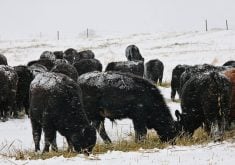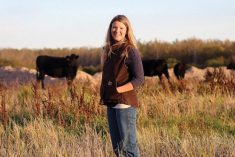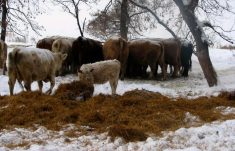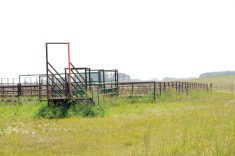Cold, wet conditions through the fall and winter were the right recipe for winterkill in alfalfa pastures across the Prairies.
“With climate change, the risk of forage stands being injured or killed by environmental stresses is predicted to increase,” said Bill Thomas, owner of BT Agronomy in Truro, Nova Scotia.
“Just in the last month, we’ve had temperatures probably as high as 8 C to as low as -18 C in this area, so we’re probably being set up for another winterkill.”
Cold and fluctuating temperatures, ice sheeting, and excess soil moisture up the rate of winter injury and kill, Thomas said in a Beef Cattle Research Council webinar.
Read Also

Farming Smarter receives financial boost from Alberta government for potato research
Farming Smarter near Lethbridge got a boost to its research equipment, thanks to the Alberta government’s increase in funding for research associations.
When properly hardened off, many perennial forage species can tolerate temperatures as low as -15 C. But below these temperatures, plants will freeze, causing injury and death, depending on the length and intensity of the cold.
“Alfalfa has been shown to tolerate temperatures of -20 to -26 C for a few hours, but it can be damaged at temperatures of -10 C when exposed for a few days” if there’s no snow cover, said Thomas, adding stands can withstand lows of -30 C if there is sufficient snow cover.
Warm spells can also be a killer.
“Warm temperatures anywhere between 0 to 5 C depending on the species can cause the forage plant to deharden or break dormancy. If that’s followed by an extreme cold or icy weather, severe winter injury or kill may result.”
Wet soils in the fall prevent plants from hardening fully.
“The plants go into the winter under stress, and if the plants are under stress in the winter, they’re far more vulnerable to winter injury and kill.”
Scouting early and often is the best way to overcome the production loss, said Christine O’Reilly, forage and grazing specialist with Ontario’s Ag Ministry.
“I call it your early warning system because, if you do it right at green-up, you’ve got a chance if you notice a problem to get on the phone with your seed dealer and figure out how you’re going to deal with it,” said O’Reilly, who joined Thomas on the webinar.
“Plant counts and root health assessments are your early warning system. They will help you flag a big problem early on so that you can have your seed in place and your equipment ready to go as soon as conditions are fit to plant.”
Scout early and often
Start your plant counts once the snow has melted and pastures are starting to green up, she said.
“You’re basically going out there just as those little green shoots are coming up and seeing how many healthy plants you have in your field — what actually overwintered,” said O’Reilly.
The number of healthy plants you need will depend on how old the stand is.
“With an older stand, you don’t need as many plants to get the same yield potential as a younger stand.”
With a new seeding, you should be targeting 20 or more healthy plants per square foot. In the first and second production years, those numbers will drop slightly, to 12 to 20 plants in year one and eight to 12 plants in year two.
“If you’re growing an alfalfa-grass mixture, you can usually go to the lower end of the range because the grasses will make up some of the yield,” O’Reilly said. “In a straight alfalfa stand, you’d want to be looking for numbers at the higher end of the range so you can hopefully meet your yield potential.”
Also check the health of the root system by digging up some roots and cutting them open to check their colour and texture.
“A healthy root should be the creamy off-white colour of most potatoes. If the root is yellow or brown, that’s rot in the root. And if it’s ropey or stringy inside, that’s not a healthy root either.”
Any plant with unhealthy roots should not be included in your plant count.
“If you go to a few spots in your field and dig up a few plants and you’re noticing that maybe half the plants you dig up have sick roots below the ground even though they look fine above ground, then take the average plant count and divide that number by two.”
Later on in the spring, go back into the field for another count — this time, stems.
“We have our early warning system, so we’ve averted total disaster by being proactive,” said O’Reilly. “Now we want to see how likely we are to actually get full yield from this crop.”
Counts of 55 or more stems per square foot “should be able to give you everything they’re genetically capable of before weather and disease and insects get a hold of them.” Counts in the range of 40 to 50 stems per square foot should yield between 75 to 92 per cent of their yield potential, while anything less than 40 stems per square foot “is not worth keeping.”
“You’ve lost 25 per cent of your yield right out of the gate, but there are also the economics behind it,” she said.
“When we’re making hay, harvest is a fixed cost. There’s very little change in the amount of fuel you use and the amount of wear and tear on equipment whether you’re harvesting a very light crop or a very heavy crop.
“So if you have a very low-yielding hayfield, your cost per tonne is much higher than if you have a high-yielding hayfield. Because harvest is the most expensive part of growing a hay crop, generally if an alfalfa stand has less than 40 stems per square foot, we say it’s not worth holding on to.”
But there are a number of things that producers can do throughout the growing season to reduce the risk of winterkill, said O’Reilly. That includes selecting disease-resistant and winter-tolerant varieties, applying the right fertility, respecting the fall rest period by not taking a late cut off your hay, and — perhaps most importantly — getting out into the field early and often.
“Please scout your fields early and scout them often, because staying on top of pressures during the growing season really can make a difference.”















